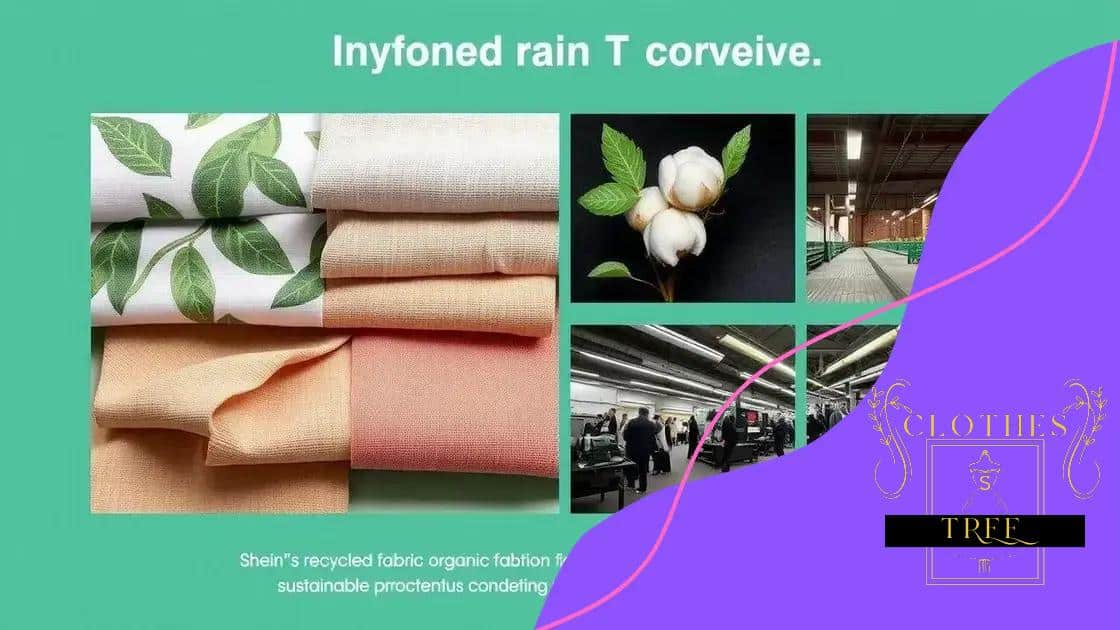How Shein balances affordability with sustainable practices

How Shein balances affordability with sustainable practices involves adopting eco-friendly materials, optimizing production methods, and responding to consumer demand for environmentally responsible fashion, shaping the future of sustainable fast fashion.
How Shein balances affordability with sustainable practices is an intriguing question for many consumers today. With the rise of eco-conscious shopping, it’s important to explore how a leading fast fashion retailer navigates this complex landscape.
The journey of Shein’s sustainable practices
The journey of Shein’s sustainable practices is quite fascinating. With the rise of eco-conscious shopping, they have made strides to adjust their business model. They realized that many consumers care about the environmental impact of their purchases. Therefore, sustainability is now becoming part of their brand identity.
Initial Steps Towards Sustainability
Initially, Shein faced challenges in implementing sustainable practices. However, they committed to improving their approach to fashion by focusing on eco-friendly materials and production processes. Here are some key steps they’ve taken:
- Adopting eco-friendly materials like recycled polyester.
- Reducing waste through more efficient production methods.
- Encouraging customers to recycle their old clothes.
These initiatives show that they are making conscious choices to reduce their carbon footprint.
Collaboration with Sustainable Brands
Shein has also partnered with various sustainable organizations. This collaboration aims to enhance its environmental practices. By joining forces with experts, they gain insights to improve their operations. Through these relationships, they drive innovative solutions that incorporate sustainable fashion into their core business.
Impact on Consumer Behavior
The impact of Shein’s sustainable practices has led consumers to rethink their shopping habits. Many now seek brands that align with their values. This shift is pushing fast fashion companies to adopt similar practices. Shein is not only responding to this demand but also setting a trend in the industry.
As a result, the conversation around sustainability in fashion is growing. Shein’s movement shows that it’s possible to blend affordability with eco-friendly practices.
Affordable fashion and its environmental impact
Affordable fashion has become a popular choice for many shoppers. However, its environmental impact raises important questions. Understanding the link between affordability and sustainability is crucial for consumers today. Many people are unaware of how fast fashion contributes to waste and pollution.
Impacts of Fast Fashion
The rise of affordable fashion directly influences consumer habits. People often prioritize low prices over sustainability. This has led to some significant environmental issues:
- Increased textile waste due to frequent clothing turnover.
- High water consumption used in production.
- Pollution from chemicals in fabric production.
These factors highlight how convenient and cheap clothing can come with hidden costs.
Consumer Awareness and Change
Fortunately, consumer awareness is growing. Many shoppers are now looking for ways to make more sustainable choices. They are considering how their purchases affect the planet. This change is pushing brands like Shein to rethink their strategies. By enhancing sustainability, they hope to align with consumer values.
As a result, some affordable brands are exploring more eco-friendly materials. They are starting to invest in technologies that reduce environmental harm. For example, recycled polyester and organic cotton are becoming popular choices.
Balancing Costs with Eco-Conscious Efforts
While the challenge remains, finding a balance between affordability and sustainability is key. It is vital for brands to support sustainable practices while keeping prices accessible. This balance will ensure that fashion remains enjoyable for all without sacrificing our environment. By making informed choices, consumers can influence the industry towards greener options.
Innovative materials used by Shein

Shein is embracing innovative materials to redefine the fast fashion industry. By incorporating eco-friendly substances, they aim to lessen their environmental footprint. Understanding these materials can help consumers make better choices.
Types of Innovative Materials
One exciting trend in Shein’s production is the use of recycled materials. This includes fabrics made from plastic waste, which reduces pollution. Here are some key innovative materials used:
- Recycled Polyester: Made from plastic bottles, this fabric saves resources and reduces waste.
- Organic Cotton: Grown without harmful pesticides, it benefits the environment.
- Tencel: A sustainable fabric made from wood pulp, known for its softness and biodegradability.
These materials highlight Shein’s commitment to sustainability.
Benefits of Using Innovative Materials
By using these innovative fabrics, Shein not only attracts eco-conscious consumers but also enhances the quality of their products. Sustainable materials can lead to:
- Lower environmental impact in production.
- Improved durability of clothing items.
- Higher customer satisfaction due to better quality.
This shift aligns with the growing demand for sustainable fashion options. Consumers are now looking to support brands that prioritize the planet.
As Shein incorporates more innovative materials, they also educate customers about the benefits. This engagement creates a responsible shopping experience, encouraging a positive change in the fashion industry.
Consumer response to sustainability efforts
Consumer response to sustainability efforts has grown significantly in recent years. More people are looking for brands that demonstrate a commitment to the environment. This change reflects a larger trend in consumer behavior, as shoppers want to align their purchases with their values.
Growing Awareness
As awareness of climate change and environmental issues rises, many customers are becoming more selective. They actively seek information about a brand’s sustainability practices. Here are some factors influencing their response:
- Transparency: Brands that openly share their sustainability efforts tend to win consumer trust.
- Eco-Friendly Products: Offering products made from sustainable materials attracts eco-conscious shoppers.
- Company Activism: Consumers appreciate when brands take a stand on environmental issues.
These factors show how a brand’s commitment can influence purchasing decisions.
Impact on Brand Loyalty
Customers reward brands that take steps towards sustainability. Many are willing to pay a premium for eco-friendly products. This willingness signals a shift in market demands, prompting brands like Shein to adapt. By listening to consumers, they can improve their practices and remain competitive.
Furthermore, brands that fail to prioritize sustainability risk losing customers. People are now more focused on the impact of their choices. As they express their preferences through purchases, companies must respond accordingly.
Engagement Through Education
Shein and other brands are increasing consumer engagement through education. By informing shoppers about the importance of sustainability, they foster a sense of responsibility. This effort not only builds brand loyalty but also encourages informed purchasing decisions.
As consumers continue to respond positively to sustainability efforts, brands have the opportunity to shape the future of fashion. Positive engagement helps create a community of environmentally conscious shoppers.
Future of sustainability in fast fashion
The future of sustainability in fast fashion is becoming a vital topic for consumers and brands alike. As environmental concerns rise, the industry is at a crossroads. The need for change is urgent, pushing brands to innovate and adapt.
Emerging Sustainable Practices
Brands like Shein are exploring new sustainable practices to enhance their operations. They are starting to focus on different areas such as:
- Waste Reduction: Implementing strategies to minimize waste, from design to production.
- Eco-Friendly Sourcing: Choosing materials that have less impact on the environment.
- Responsible Manufacturing: Ensuring fair labor practices and reducing environmental harm during production.
These improvements show a shift towards more sustainable business models.
Technology’s Role
Technology offers many solutions to support sustainability in fast fashion. For example, advanced technologies are being used to track production processes and manage resources more effectively. By leveraging data, brands can:
- Optimize supply chains to reduce waste.
- Analyze customer behavior to produce only what is needed.
- Innovate with recycled materials to create new fashion lines.
This technology is crucial for driving sustainability initiatives within the industry.
Consumer Influence and Demand
The role of consumers is also a key factor in the future of sustainable fashion. As shoppers increasingly demand eco-friendly options, brands must respond. The following trends are evident:
- More consumers are willing to pay a premium for sustainable items.
- Social media encourages discussions about sustainability, influencing brand practices.
- Shoppers prefer to support companies that demonstrate clear environmental commitments.
As consumer awareness grows, it will shape the industry landscape.
FAQ – Questions About Sustainability in Fast Fashion
What materials is Shein using to improve sustainability?
Shein is adopting eco-friendly materials like recycled polyester and organic cotton to reduce its environmental impact.
How do consumers influence fast fashion brands?
Consumers increasingly demand sustainable options and are likely to support brands that showcase a commitment to environmentally friendly practices.
What role does technology play in sustainable fashion?
Technology helps brands track their production processes, optimize supply chains, and analyze customer behavior to promote more sustainable practices.
Why is transparency important for fashion brands?
Transparency builds trust with consumers, as they prefer brands that openly share their sustainability efforts and impact.





